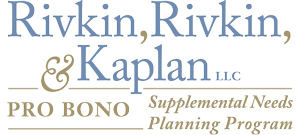We want potential participants to be fully aware of the limited planning options available through the Pro Bono Supplemental Needs Planning Program.
To allow us to serve as many families as possible with the resources available, the program does not include planning to avoid probate, minimize estate and other transfer taxes, defer and minimize income taxes on distributions from IRAs and employer retirement plans, or qualify the parents for Medicaid. In addition, the program places limits on the choices of fiduciaries and the alternatives for distributing assets at death.
Probate is a procedure that each state has to govern the disposition of assets located in that state when someone dies. It is intended to create an orderly process at death that protects third parties, such as a hospital, that might have a claim on the decedent’s assets. Although probate often is not as burdensome as many people fear, it is time-consuming (in Illinois, for example, the process takes at least 6 months), and it does result in legal fees and court fees. The time and cost of probate often can be avoided with careful attention to asset ownership and beneficiary designations.
Jointly-owned assets, assets with a designated beneficiary, and assets owned by a living trust all can pass outside of probate at death. As a result, married couples can avoid probate in some cases simply by using a combination of joint ownership and beneficiary designations. In other cases, probate can be avoided by titling those assets that do not have a joint owner or beneficiary in the name of a revocable living trust. A revocable living trust is a trust that you control and that can hold assets during your life and after your death.
Revocable living trusts are beyond the scope of this pro bono program.
If a married couple has assets (including the death benefit on life insurance) that exceed the state or federal estate tax exemption amounts in any year, there are a number of techniques they could use to minimize estate tax exposure, including credit-shelter trusts and irrevocable life insurance trusts.
These techniques are beyond the scope of this pro bono program.
Public benefits (namely, Supplemental Security Income and Medicaid) are available for individuals with a qualifying disability whose assets and income are below prescribed thresholds. The financial qualification rules differ for married couples versus single persons. Certain resources are considered exempt when determining countable resources, and there are a variety of techniques and transfers which might be able to be utilized in facilitating eligibility for public benefits.
This pro bono program is intended to preserve eligibility for public benefits for the children of program participants; it is not designed to facilitate eligibility for public benefits for the program participants themselves, and any techniques to that end are beyond the scope of this program.
The SECURE Act, which went into effect on January 1, 2020, eliminated the previously-advantageous “stretch IRA” for all but a few categories of beneficiaries of an IRA or employer retirement plan, allowing only those beneficiaries to take distributions over their life expectancy, thereby deferring and possibly reducing the income taxes owed on such distributions. Individuals with disabilities or chronic illnesses qualify for this selective and advantageous treatment.
As a result of these rules, if an individual has an IRA or employer retirement plan and multiple children, one of whom has special needs, there might be income tax benefits to naming a supplemental needs trust for that child as the beneficiary (or contingent beneficiary after the spouse, if the individual is married) of all or a disproportionate share of that IRA or employer retirement plan. In such a case, for equalization, the individual might consider allocating a greater share of other assets to that individual’s other child or children.
However, these considerations and techniques are beyond the scope of this pro bono program.
To create an estate plan, including supplemental needs trusts for your child with special needs, you will need to (i) select fiduciaries you trust to step into your shoes for various roles if you die or become incapacitated, and (ii) determine the disposition of assets at death. To minimize the complexity of the planning, and thereby help keep program costs down, we place a number of limits on the choices of fiduciaries and on the alternatives for distributing assets at death.

If these limitations do not work for your family, we encourage you to consult either with another estate planning attorney that has supplemental needs planning experience, or with our office outside of the pro bono program, in order to prepare appropriate documents for you.
LIMITED CHOICES
To minimize the complexity of the planning, and thereby help keep program costs down, we place the following limits on the choices of fiduciaries and on the alternatives for distributing assets at death.
As part of the planning process, you will need to select fiduciaries you trust to step into your shoes for the following roles if you die or become incapacitated:
Guardian
The person or persons who will care for your minor children or disabled adult children if you – and, if married, your spouse – die or become incapacitated
Health Care Agent
The person who will make medical decisions for you if you become incapacitated
Property Agent
The person who will make financial decisions for you if you become incapacitated
Executor and Trustee
The person or trust company that will handle your financial affairs and manage the trusts for your children at your death (or, if married, at the death of the survivor of your spouse and you)
Fiduciary choices under the program are limited as follows:
- You may not name co-agents, co-executors, or co-trustees
- You are permitted to name co-guardians, if they are married to each other
- You may name only U.S. residents to serve as fiduciaries
- If you are married:
- You must name your spouse as first property agent, health care agent, executor, and trustee
- You each must also name the same succession of guardians and successor property agents, executors, and trustees
- You are permitted to name different successor health care agents
Under the program, the distribution plan for your assets at death is limited in the following ways:
- If you are married:
- You must leave everything to the surviving spouse at the first death
- Any children from a prior relationship must be treated the same as children of the current marriage
- At your death (if you are single), or at the death of the survivor of your spouse and you (if you are married):
- You may choose to leave up to 3 dollar-amount gifts “off-the-top” to individuals or charities (e.g., $500 to a favorite charity or relative)
- Your remaining assets will be divided equally among your children, with the one available alternative being a double share for your child with special needs
- The share for your child with special needs will be allocated to a third-party supplemental needs trust for that child
- You may choose to have the shares for each of your other children distributed outright (after the child reaches age 18) or retained in a separate trust for the child’s health, education, and support until they reach a certain age chosen by you
- You may name contingent beneficiaries to receive the remaining assets if none of your descendants were to survive you. The contingent beneficiaries may be:
- Your siblings (or ½ to each side’s siblings, in the case of a married couple), or
- Up to 8 individuals or charities that would share equally in the remaining assets


